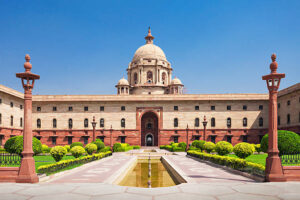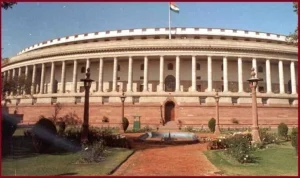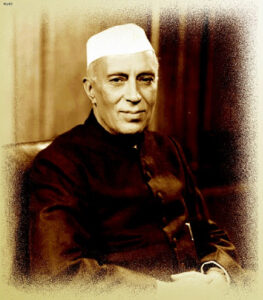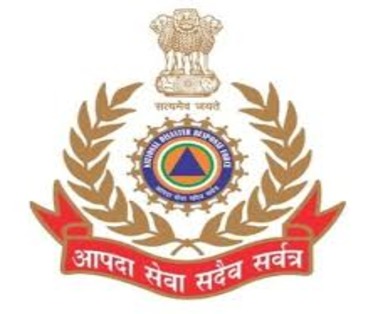Introduction:
India’s journey to becoming a Republic in 1950 involved a meticulous process of dismantling symbols of British rule, particularly from prominent government buildings like Rashtrapati Bhavan and the Parliament House. This blog unravels the intriguing story behind the removal of imperial insignias and the decision-making process surrounding their fate.
The Historical Shift:
The period between Independence in 1947 and the adoption of the Constitution in 1950 marked a transitional phase for India. Although free from British rule, the country operated as a constitutional monarchy until the Republic was officially declared on January 26, 1950. During this transition, the Central Public Works Department (CPWD) took on the monumental task of erasing visual reminders of the British Empire.
Rashtrapati Bhavan: A Symbolic Transformation:
Formerly known as the Viceroy’s House, Rashtrapati Bhavan underwent a symbolic transformation as it shed its colonial past. The CPWD meticulously removed 44 bronze crowns from the main gate, valued at Rs 8,000, along with an additional 16 crowns atop English lions, valued at Rs 1,000. Various corners of Rashtrapati Bhavan saw the removal of around 50 more crowns, varying in weight and collectively valued at Rs 3,000.

Parliament House: Witness to Constitutional Debates:
The (old) Parliament House, a witness to the deliberations of the Constituent Assembly, underwent a similar process. Paintings of previous Viceroys, King George V, and the Prince of Wales adorned its walls. Bronze and marble crowns were removed, along with a plaster of Paris coat of arms from the Press Gallery. The Chamber of Princes, transformed into the Parliament library, retained a British coat of arms with a gold finish.

The Dilemma of Disposal:
As the question arose regarding the fate of these removed insignias, various opinions surfaced. The UK High Commissioner in New Delhi expressed interest in acquiring them, particularly the bronze crowns. Union Minister Narhar Vishnu Gadgil proposed melting the bronze items to create Republican insignias, while other materials could be gifted to the UK High Commission as museum pieces.
Nehru’s Conservative Stance:
Prime Minister Jawaharlal Nehru, however, adopted a more conservative approach. His personal secretary, Dharma Vira, emphasized the need for careful consideration before deciding on the disposal of these artifacts. While the UK High Commissioner was informed that the items wouldn’t be used further, a definite decision was pending.

Sentimental Requests and Bureaucratic Considerations:
Personal requests from serving and retiring British officers, such as Major-General Harold Williams, added a layer of complexity. Despite the inclination of bureaucrats to part with a few crowns for sentimental reasons, Nehru’s directive to preserve British relics prevailed. The bureaucratic dance highlighted the delicate balance between historical significance and diplomatic considerations.
The Legacy of Change:
Ultimately, the decision to retain and safeguard these artifacts reflected India’s commitment to preserving its history, even as it underwent profound changes. The blog postulates on the potential significance of these symbols, the negotiations surrounding their fate, and the enduring legacy of a nation transitioning from colonial rule to a sovereign republic.
Conclusion:
The removal of British symbols from Rashtrapati Bhavan and the Parliament House stands as a testament to India’s commitment to forging a new identity post-independence. The careful deliberations, the clash of opinions, and the diplomatic considerations surrounding the fate of these insignias provide a fascinating glimpse into a pivotal period in India’s history.
Disclaimer:
The information provided in this blog is based on historical events and accounts available up to the knowledge cutoff date of January 2022. While efforts have been made to ensure accuracy, readers are encouraged to cross-reference information with authoritative sources for the most up-to-date and comprehensive understanding.
The views expressed in this blog are those of the author and do not necessarily reflect the official stance of any government, institution, or organization. The purpose of this content is to provide historical insights and reflections on India’s transition to a Republic, and any interpretation of events is subject to individual perspectives.
Readers are advised to use their discretion and judgment when interpreting historical narratives, as historical contexts and interpretations may vary. The inclusion of external links is for informational purposes only and does not imply endorsement or validation of the content on those websites.
The author and the platform do not assume responsibility for any consequences or actions taken by readers based on the information presented in this blog. If in doubt, readers are encouraged to consult qualified professionals or experts in the relevant field for accurate and personalized information.



